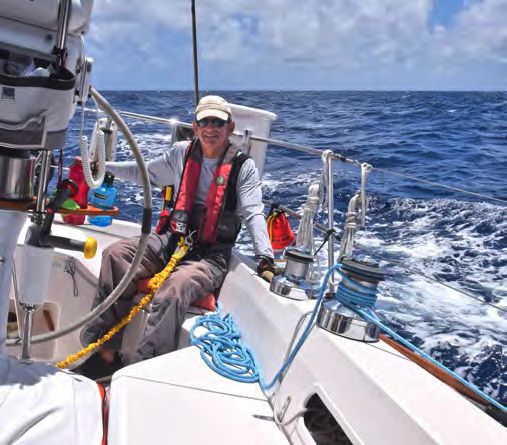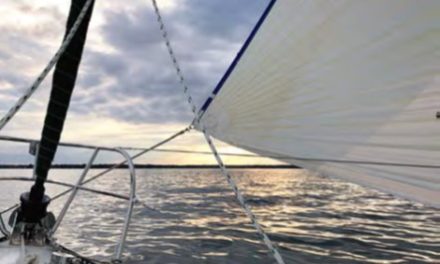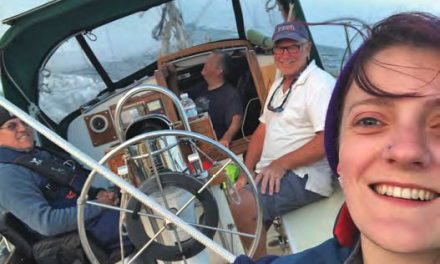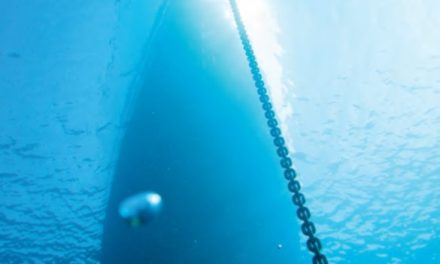A coastal sailor jumps at the chance to cross an ocean
Issue 151: July/Aug 2023
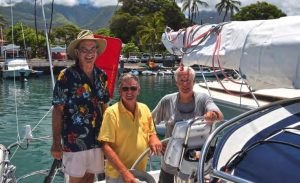
Rick Wunderlich, left, with author Bert Vermeer and skipper Chris Read in Lahaina Harbor, Maui, on departure day.
A lifetime of sailing the protected waters of Vancouver Island on British Columbia’s west coast had given me a wealth of sailing experience — but no ocean crossing.
I had dreamed of that possibility but realized that an old 30-foot coastal cruiser was not a practical boat for such an adventure. Sure, I had sailed the west side of Vancouver Island’s open ocean, and conditions there could be as treacherous as any other stretch of water in the world, but a safe anchorage was always within reach. What would it be like to really head out into the wild blue yonder? There are plenty of books to read and videos to watch, but that’s not the same as being there.
Then an opportunity came up. A sailing friend announced that he was planning to participate in the 2016 Vic-Maui International Yacht Race, doublehanded, aboard his Sabre 386. Chris had crossed oceans before and had an experienced sailing buddy as crew for the race; would I be interested in helping bring Amiskwi back to Victoria as a third crew member? Of course I would! What an opportunity! I knew the boat well; I looked after her during the winter months and had worked on her in the past. In the yearlong preparation for the race, Chris, Rick, and I undertook some major projects to comply with the offshore racing standards. I felt comfortable with the boat, and both Chris and Rick were good buddies and competent sailors. My concern was myself. Could I live up to their expectations and the demands of ocean sailing?
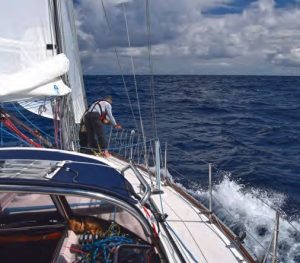
Rick and Chris work to resolve a furler issue.
Having sailed in big seas and rough water, I knew I was prone to seasickness if I wasn’t driving the boat. That would prove a challenge for any long-distance trip. I secured a supply of seasickness pills from a local pharmacist, medication that I had used before and knew would work without putting me to sleep. I also purchased scopolamine transdermal patches as a worst-case backup plan. I had used them years before when instructing high-speed driver’s training (watching the driver, not the road) and I knew they also worked for me when I was in continuous motion.
Race day arrived, and Chris and Rick soon drifted out of view off the Victoria waterfront. I followed their progress with the Racetracker app, providing communication support as needed. Upon arriving in Maui, I found Amiskwi secured, Mediterranean-style, at the tiny Lahaina harbor after a successful 17-day race. The boat was in excellent condition and required little in the way of repair, but purchasing portable containers for additional fuel for the return trip was a challenge. The fleet seemed to have cleaned out local supplies.
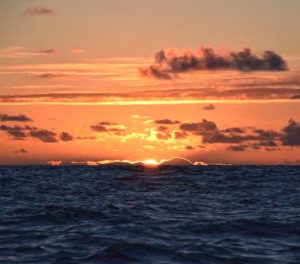
A glorious mid-Pacific sunset.
Anticipation was running high the day before departure, with a nervous excitement. I was worried. Would I be able to function if I got sick? Would I be a liability to my buddies? I could picture myself heaving over the side for days on end, perhaps forcing the boat back to Maui to throw me on the beach. I decided to forgo the pills and go straight to the patches, sticking one behind my ear as I climbed into bed for one last night ashore.
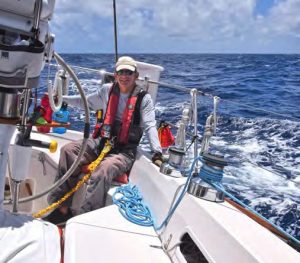
Rick at the helm just north of Maui, with 2,700 nautical miles to go.
I woke up the next morning and crawled out of bed — only to promptly fall on my face. Oh, did I feel bad! I was nauseated and could hardly stand. Obviously, the patch was not agreeing with me this time. Oh well, nothing to do but tough it out. I forced myself to adapt, packed up, and wandered down to the harbor, hoping the effects of the patch would dissipate with fresh air and action. I didn’t want to give up just yet. I was first to Amiskwi and washed the accumulated sand off the deck, then realized the portlights had been left open overnight. Seems this just wasn’t going to be my day.
Chris and Rick arrived with an entourage of family and friends for the big send-off. There was hardly a ripple on the water as we maneuvered out of the narrow harbor entrance. We brought in the fenders and removed the sail cover as we motored around the lee side of Maui and abruptly into the 20-knot-plus trade winds and 6-foot swells. A hot sun and warm, humid wind enveloped us as we sailed due north on a tight reach, spray flying back to the cockpit.
The sailing conditions were spectacular, the stuff I had dreamed of. But I didn’t last long. Already nauseated from the patch, I was soon on the lee rail feeding the fish. Great start! The guys were rather nonplussed about it, and I saw the occasional smirk.
We divided watches into three-hour rotations, and I stood mine as required, sick or not. I gave up on the patch and went back to the pills. As the first sunset approached, it idly crossed my queasy mind that we should be looking for an anchorage soon. Ha! That wasn’t going to happen. I slept in the cockpit.

The sailing conditions were varied and exciting.
By the end of day two I was back on my feet again, feeling a bit deflated but able to function. I could start enjoying the experience. And what an experience, with warm, turquoise water and blue skies, and steady wind just off the bow as we thrashed to windward under jib and reefed main. We were on a starboard tack for the next 10 days. There were spectacular golden sunsets, a glowing moon during the nights, and Orion emerging from the eastern horizon to herald the coming day. The windvane did yeoman service keeping us on course, aimed due north to avoid the large high-pressure system that dominates off the B.C./ Washington state coast during the summer months.
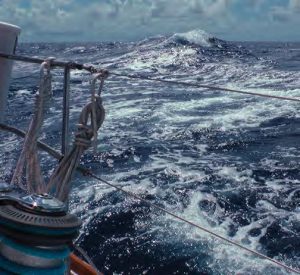
Even the squalls were enjoyable.
The days started going by in a blur. The wind, the sunsets, the moon overhead, and the squalls rolling in from the east were all fabulously enjoyable for a neophyte. The trade winds subsided as we traveled north, the boat motion easing considerably. At one point it was like sailing in the protected waters of the Canadian Gulf Islands, perfect conditions as we read books, prepared meals, and enjoyed lively conversations. Dolphins came and went, and the shadows of small shearwaters fluttered across the mainsail under the full moon, as they laughed like the munchkins in The Wizard of Oz. Countless Pacific man-of-war covered the water for miles, their tiny white sails catching the wind with determination as we sailed through the carpeted waves. The occasional frigate bird skimmed the wavetops, keeping a respectful distance. There was no sign of any other boat on the horizon, even though we knew there were others traveling nearby, also headed back to Victoria.
Having experienced many years of shift work, I knew how long and lonely those dark hours could be. I had a bag of hard candies at the binnacle and an iPad full of music at hand. While on watch in the wee hours I would stand up every three tunes and do a complete sweep of the horizon, searching for any sign of a commercial vessel. Near the end of one midnight watch, I was driving the boat down a canyon of white cliffs with a full moon overhead when I spotted a white farmhouse ahead with a white picket fence. It was getting closer, and I could see a children’s swing beside the porch. I would have to tack or head down to avoid a collision!
I was ready to call the guys on deck, the standing rule being any change in direction required at least two on deck. I was moving toward the companionway when I came to my senses, realizing with a laugh that it was a hallucination caused by fatigue. I can see that house and picket fence to this day.

Water rises over a windward portlight as the waves grow bigger.
As we sailed north, word came that the North Pacific High between us and the B.C. coast had narrowed into an hourglass shape. Should we turn east toward the narrowing section where wind was likely to be nonexistent? Or continue north toward Alaska, staying in the wind, and sail around the top of the system? We had extra fuel aboard to cross the high, and continuing north was a much longer route. We decided to tack and head east.
Under graying skies, the wind went light and then virtually calm, the long ocean swells rolling by from the northwest. At the most economical engine speed, we powered for a day and a half, aiming for the midpoint of Vancouver Island, well north of the Strait of Juan de Fuca and our destination. We knew there would be a river of northwest wind on the far side of the Pacific High and feared being swept down the Washington coast, or even worse, the Oregon coast. Having to tack to windward to reach the mouth of the strait against the anticipated winds would be brutal.
Finally, under magnificently clear skies and a canopy of stars overhead, a breeze heralded the beginning of the northwesterlies. Each mile brought stronger winds as we sailed out of the Pacific High and into a wall of wind. Before long, we hoisted a smaller jib and double-reefed the main. Chris and Rick crawled forward on hands and knees, the bow plunging into cold, dark water in the predawn light. By mid-morning, the long, cresting rollers and 25-plus-knot winds were creating a maelstrom of sound and motion as Amiskwi raced for home, hard on the wind.
The jib was soon rolled up and replaced by the small storm sail hanked onto the inner forestay. What a day! What a sail! Moving mountains of deep blue water beneath a brilliant sky, whitecaps as far as the eye could see, every movement aboard carefully planned before letting go of anything. This was ocean sailing at its most thrilling. The windvane was able to maintain a steady course, the on-watch sailor making minor adjustments while unsuccessfully trying to keep dry. Foul weather gear eventually turned into personal swimming pools. Evening approached with another spectacular sunset casting golden shadows on the mountains surrounding us.
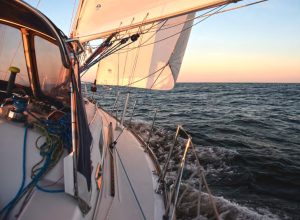
The heavy winds ease as Amiskwi approaches the coast during the last evening on the open ocean.
We shortened watches to two hours and, as darkness enveloped us, we entered a very small world confined to the nearest crest, the next trough. Amiskwi plunged onward, bullets of spray flying back into the cockpit. With my back turned to the wind and spray, I would turn for a glance to windward, watching for large commercial vessels bearing down on us. The view was intimidating. Towering snow-topped mountains seemed destined to crash into the cockpit, but always slid under the stern. The instruments showed a steady 35-plus knots, with higher gusts. I had total confidence in the boat, what Rick and Chris called “naive optimism.” I knew the boat was built for these conditions and well maintained. Should a mechanical failure happen, it would be met with three competent and motivated sailors. I was having a blast.
The second day of the big wind saw the pressure start to ease as we approached the west side of Vancouver Island. Out of the haze, I watched an oceangoing freighter on a reciprocal course about 8 miles to windward. Behind the freighter was the faint outline of a mountain range. Vancouver Island! I identified Mount Ozzard at the north edge of Barkley Sound with its large white radar dome, a familiar sight from my cruising days along the shores. One more night on the water and we’d be home.
The wind evaporated completely overnight as we drifted into the entrance of the Strait of Juan de Fuca, the full moon shimmering on glassy water, the lights of Neah Bay to starboard. Motoring past Victoria to our home port of Sidney was a bit anticlimactic after such a raucous sail. Family and friends welcomed us into the marina with an unexpected dock party, a fitting end to our experience. Although I was glad to be home, our arrival felt a little poignant. It had been an amazing 18 days of sailing, and it was already over. The anticipation of getting home conflicted with the wish that the trip would go on and on.
Later, the inevitable question arose: Would I do another ocean crossing? In reflection, it would have to be with the right boat and crew. This crossing was an experience that would be difficult to beat.
Bert Vermeer and his wife, Carey, live in a sailor’s paradise. They have been sailing the coast of British Columbia for more than 40 years. Natasha, an Islander Bahama 30, is their fourth boat (following a Balboa 20, an O’Day 25, and another Islander Bahama 30). Bert tends to rebuild his boats from the keel up. Now, as a retired police officer, he also maintains and repairs boats for several nonresident owners.
Thank you to Sailrite Enterprises, Inc., for providing free access to back issues of Good Old Boat through intellectual property rights. Sailrite.com

